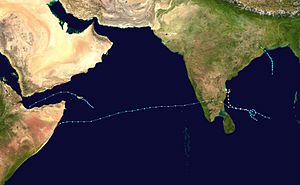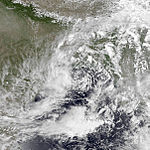1984 North Indian Ocean cyclone season
| 1984 North Indian Ocean cyclone season | |
|---|---|

Season summary map
|
|
| Seasonal boundaries | |
| First system formed | May 23, 1984 |
| Last system dissipated | December 10, 1984 |
| Strongest storm | |
| Name | Cyclone Four |
| • Maximum winds | 130 km/h (80 mph) (3-minute sustained) |
| • Lowest pressure | 973 hPa (mbar) |
| Seasonal statistics | |
| Cyclonic storms | 4 |
| Total fatalities | Unknown |
| Total damage | Unknown |
| Related articles | |
| Tropical storm (SSHWS) | |
| Duration | May 23 – May 28 |
|---|---|
| Peak intensity | 85 km/h (50 mph) (1-min) 990 hPa (mbar) |
| Tropical storm (SSHWS) | |
| Duration | October 10 – October 14 |
|---|---|
| Peak intensity | 85 km/h (50 mph) (1-min) 980 hPa (mbar) |
| Category 2 tropical cyclone (SSHWS) | |
| Duration | November 9 – November 15 |
|---|---|
| Peak intensity | 155 km/h (100 mph) (1-min) 975 hPa (mbar) |
| Category 1 tropical cyclone (SSHWS) | |
| Duration | November 27 – December 8 |
|---|---|
| Peak intensity | 140 km/h (85 mph) (1-min) 973 hPa (mbar) |
The 1984 North Indian Ocean cyclone season was part of the annual cycle of tropical cyclone formation. The season has no official bounds but cyclones tend to form between April and December. These dates conventionally delimit the period of each year when most tropical cyclones form in the northern Indian Ocean. There are two main seas in the North Indian Ocean—the Bay of Bengal to the east of the Indian subcontinent and the Arabian Sea to the west of India. The official Regional Specialized Meteorological Centre in this basin is the India Meteorological Department (IMD), while the Joint Typhoon Warning Center (JTWC) releases unofficial advisories. An average of five tropical cyclones form in the North Indian Ocean every season with peaks in May and November. Cyclones occurring between the meridians 45°E and 100°E are included in the season by the IMD.
On May 23 a tropical depression developed in the northwest Arabian Sea. It drifted west-northwestward, slowly organizing into a tropical storm on the 26th. It tracked westward through the Gulf of Aden, reaching a peak of 50 mph winds before hitting northern Somalia on the 28th. It quickly dissipated, after becoming the only North Indian tropical cyclone in recorded history to transit the Gulf of Aden.
Tropical Storm Two, which developed on October 10 in the central Bay of Bengal, hit northeastern India on the 14th, causing little damage or deaths.
Tropical Depression Three formed in the south-central Bay of Bengal. It tracked west-northwestward, becoming a tropical storm on November 10 and a cyclone on the 11th. A break in the ridge brought it northward, where steering currents collapsed on the 13th. After reaching a peak of 95 mph winds the cyclone looped slowly to the west and hit India on the 14th and dissipating on the 15th. Due to the stalling just offshore, the cyclone brought torrential flooding, resulting in at least 430 fatalities and moderate damage.
...
Wikipedia








